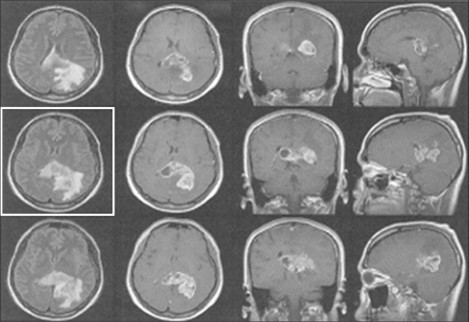Cancer Res Treat.
2011 Sep;43(3):195-198.
Second Primary Glioblastoma Multiforme Following Autologous Hematopoietic Stem Cell Transplantation in a Patient with Acute Myelogenous Leukemia
- Affiliations
-
- 1Division of Hematology, Department of Internal Medicine, Catholic Blood and Marrow Transplantation Center, Seoul St. Mary's Hospital, The Catholic University of Korea School of Medicine, Seoul, Korea. dreom@catholic.ac.kr
Abstract
- Glioblastoma multiforme (GM) is one of the most aggressive primary brain tumors, and has a poor prognosis despite intensive treatment. GM is also the most malignant astrocytoma, with histopathological features that include cellular polymorphism, rapid mitotic activity, microvascular proliferation, and necrosis. The causes of GM remain obscure, but several reports have shown associations between GM and genetic alterations and radiation exposure. Furthermore, high-dose chemotherapy/radiotherapy with autologous stem cell transplantation is increasingly being used to treat patients with leukemia, and patients who undergo stem cell transplantation have a higher risk of solid tumor cancer development later in life. Based on these associations, we discuss GM development in a patient who underwent chemoradiotherapy conditioning prior to stem cell transplantation.
MeSH Terms
Figure
Reference
-
1. Kitanaka C, Shitara N, Nakagomi T, Nakamura H, Genka S, Nakagawa K, et al. Postradiation astrocytoma: report of two cases. J Neurosurg. 1989; 70:469–474. PMID: 2536806.2. Nagarajan RP, Costello JF. Epigenetic mechanisms in glioblastoma multiforme. Semin Cancer Biol. 2009; 19:188–197. PMID: 19429483.
Article3. Yadav AK, Renfrow JJ, Scholtens DM, Xie H, Duran GE, Bredel C, et al. Monosomy of chromosome 10 associated with dysregulation of epidermal growth factor signaling in glioblastomas. JAMA. 2009; 302:276–289. PMID: 19602687.
Article4. Minniti G, Muni R, Lanzetta G, Marchetti P, Enrici RM. Chemotherapy for glioblastoma: current treatment and future perspectives for cytotoxic and targeted agents. Anticancer Res. 2009; 29:5171–5184. PMID: 20044633.5. Deeg HJ, Sanders J, Martin P, Fefer A, Neiman P, Singer J, et al. Secondary malignancies after marrow transplantation. Exp Hematol. 1984; 12:660–666. PMID: 6386505.6. Forrest DL, Nevill TJ, Naiman SC, Le A, Brockington DA, Barnett MJ, et al. Second malignancy following high-dose therapy and autologous stem cell transplantation: incidence and risk factor analysis. Bone Marrow Transplant. 2003; 32:915–923. PMID: 14561993.
Article7. Ghelani D, Saliba R, Lima M. Secondary malignancies after hematopoietic stem cell transplantation. Crit Rev Oncol Hematol. 2005; 56:115–126. PMID: 15979325.
Article8. Curtis RE, Rowlings PA, Deeg HJ, Shriner DA, Socíe G, Travis LB, et al. Solid cancers after bone marrow transplantation. N Engl J Med. 1997; 336:897–904. PMID: 9070469.
Article9. Mauch PM, Kalish LA, Marcus KC, Coleman CN, Shulman LN, Krill E, et al. Second malignancies after treatment for laparotomy staged IA-IIIB Hodgkin's disease: long-term analysis of risk factors and outcome. Blood. 1996; 87:3625–3632. PMID: 8611686.
Article10. Kulkarni S, Powles R, Treleaven J, Singhal S, Horton C, Sirohi B, et al. Melphalan/TBI is not more carcinogeneic than cyclophosphamide/TBI for transplant conditioning: follow-up of 725 patients from a single centre over a period of 26 years. Bone Marrow Transplant. 2000; 25:365–370. PMID: 10723578.11. Naranjo CA, Busto U, Sellers EM, Sandor P, Ruiz I, Roberts EA, et al. A method for estimating the probability of adverse drug reactions. Clin Pharmacol Ther. 1981; 30:239–245. PMID: 7249508.
Article12. Leiper AD. Late effects of total body irradiation. Arch Dis Child. 1995; 72:382–385. PMID: 7618901.
Article13. Salvati M, D'Elia A, Melone GA, Brogna C, Frati A, Raco A, et al. Radio-induced gliomas: 20-year experience and critical review of the pathology. J Neurooncol. 2008; 89:169–177. PMID: 18566750.
Article
- Full Text Links
- Actions
-
Cited
- CITED
-
- Close
- Share
- Similar articles
-
- A Case Report of the Second de Novo Acute Myeloid Leukemia (AML) Following Allogeneic Stem Cell Transplantation in a Patient with the First AML
- Disseminated Aspergillosis following Allogeneic Hematopoietic Stem Cell Transplantation in an Acute Leukemic Patient who was Previously Treated for Invasive Aspergillosis
- A Case of Double-unit Cord Blood Transplantation in Primary Refractory Acute Myeloid Leukemia
- Pediatric Allogeneic Hematopoietic Stem Cell Transplantation in Korea: April 2000: The Korean Society of Pediatric Hematology-Oncology
- Unusual isolated extramedullary relapse of acute lymphoblastic leukemia in the breast despite complete donor hematopoietic chimerism after allogeneic hematopoietic stem cell transplantation


